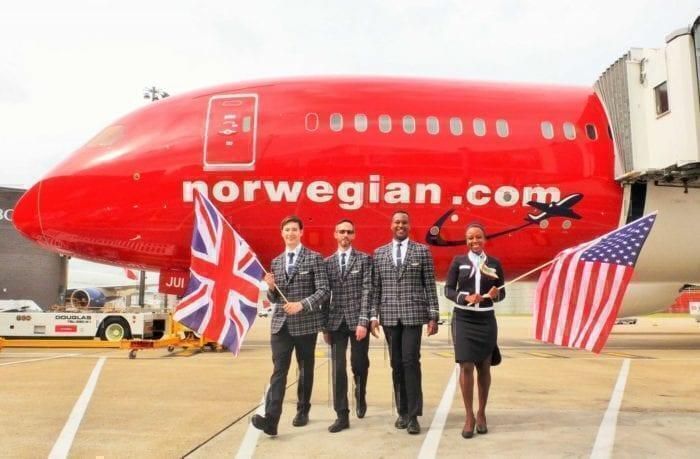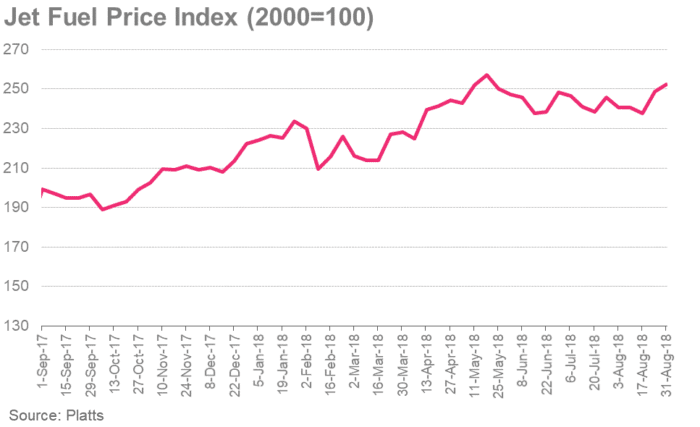A new report has revealed who are the best and worst transatlantic carriers in terms of fuel efficiency. Leading the way, as they are in so many ways right now, Norwegian scoop the crown for most efficient airline. The least efficient? The UK’s very own flag carrier, British Airways.
Released on Wednesday, the paper by the International Council on Clean Transportation (ICCT) analyses the fuel efficiency of the 20 biggest airlines running the Europe to US routes. It’s the second year running that Norwegian have taken the crown, proving that investing in a young fleet of aircraft is paying dividends.
Eight airlines including UK carriers Virgin Atlantic and Thomas Cook chalked up better fuel efficiency than they did in last year’s study. In fact, overall, the entire industry had improved, although only by 1%.
Norwegian fuel efficiency flies higher than any other
Findings of the study found that, as an average, Norwegian achieved 44 passenger kilometres per litre (pax-km/L). This is a whole third (33%) higher than the industry average and significantly higher than the second-place airline, WOW Air, who achieved 39 pax-km/L.
The routes inspected included LA to London, New York to Paris and New York to London. On the New York to London route, Norwegian burned a staggering 33% to 78% less fuel per passenger km compared to the competition who were running the same route. These included American Airlines, Delta, United and Virgin Atlantic.
British Airways fuel efficiency fail
Out of the 20 airlines studies, British Airways fuel efficiency was the worst. Achieving just 27 pax-km/L on average, they fell in behind Lufthansa, United and Aeroflot at the bottom of the table.
One of the contributing factors to the British Airways fuel efficiency fail could be their daily A318 which cruises across the Atlantic, business class only. With just 32 seats, the luxurious configuration makes it ideal for business big-wigs, but also brands it the least fuel-efficient transatlantic flight.
A BA spokesperson claimed that their copious numbers of business and first-class seats meant they moved less passengers, which made it look like they were less fuel efficient. They claimed that BA are investing in modern craft, including the 787 and A350, and that this puts them ‘on course to deliver a 25 per cent improvement in carbon emissions reduction by 2025.’
The most fuel-efficient aircraft in the world
For years now, the aviation industry has been experiencing something of a boom, as low fuel prices have meant super low fares and more competition in the marketplace. However, since OPEC announced the cuts to oil production, jet fuel prices have been steadily creeping up, and it won’t be long before passengers start to feel the effects of this on seat prices too.
When Airbus rolled the first A380 off the production line a decade ago, the idea was to transport the most amount of people in the most fuel-efficient way possible. The craft set the bar for weight reducing innovations as well as more cabin space for a comfier ride. Boeing, of course, replied with the 747.
These four-engine craft were touted as the ‘green giants’ of the skies, claiming better fuel efficiency thanks to high spec engines and larger capacity. However, the ICCT study proves that this is no longer the case. Looking earlier in the year at transpacific carriers, they discovered that the A380 actually carries relatively few passengers for the size of the craft; typically around 350 compared to 200 for the 787-9, despite having more than two times the floor space.
In fact, quad engine craft are the worst performers in terms of efficiency all round. According to the ICCT the most fuel efficient aircraft in the world right now are:
- Airbus A350-900
- Boeing 787-9
- Boeing 787-8
- Airbus A330-300
- Boing 757-300
- Boeing 777-300ER
- Boeing 737 MAX
- Airbus A321
The ICCT has pointed the finger of blame squarely at aging, oversized aircraft for dragging down the industry average fuel efficiency. Next year the industry is due to begin emissions monitoring as part of a drive to cut down on pollution from air travel.
The secret of fuel efficient airlines like Norwegian?
The key to the Norwegian fuel efficiency, or at least part of it, is the lack of gigantic aircraft. The smaller twin engine widebody aircraft, like the Boeing 787 and Airbus A350, perform far better in long distance trips than any quad aircraft. In fact, according to the ICCT, the 787-9 returns 60% more fuel efficiency than an A380.
This is no big secret in the aviation world. From both a fuel efficiency and environmental point of view, the A380 is a big fat fail. Other quad aircraft have already been discontinued, such as the 747-400 and the A340 family. Probably the A380 would have been shelved by now too, if it wasn’t for Airbus’ ongoing orders from one customer: Emirates.
Adding to Norwegians success is their lack of business class capacity, meaning they can squeeze more passengers onto each craft. This, coupled with the airlines investment in brand new, top spec, fuel efficient planes makes it clear how they have achieved a two time win.
The good news is that most airlines are turning to the more fuel efficient twinjets for future international routes, at the same time as they’re starting to mothball the bigger aircraft. No doubt fuel efficiency will continue to rise worldwide, which is good news for the planet and for our fares.
Featured Image: Norwegian


